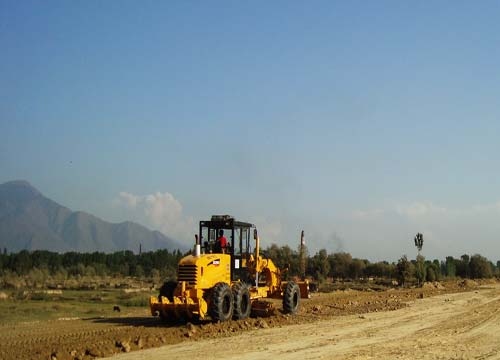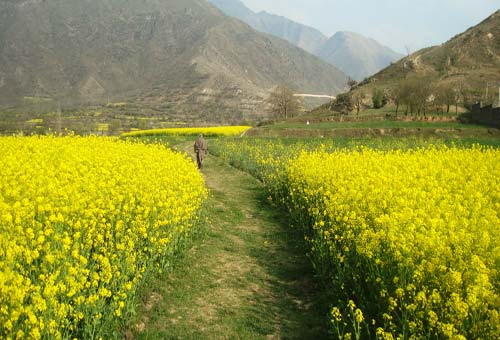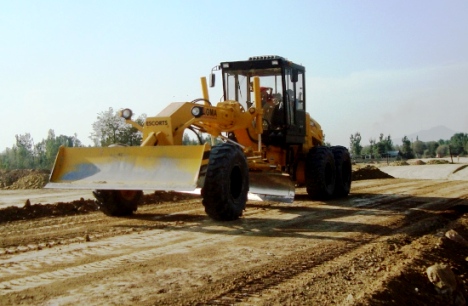As crores of rupees flow into the sleepy Letpora hamlet, a dangerous consumerism has set in among the villagers, replacing simplicity and appetite for hard work. Beneath the developmental fa?ade lies a disintegrated community that pushed saffron to backburner. Shams Irfan delves deep into how easy money creates fake prosperity.

Letpora, a small hamlet around 20 kilometres south of summer capital Srinagar, till year 2006, was known to people just for being a village through which national highway 1A passed. The people here lived a rustic life, with their prime occupation being agriculture, more particularly the saffron cultivation. As one walks away towards its upper side, the village presents a panoramic view of vast saffron fields. With an average land holding of around 50 kannals per household, People in Letpora lived a satisfied life in terms of economy.
But the destiny of this village changed forever, after three new major projects were listed around the village benefiting the natives monetarily.
In 2006, state government identified 700 kanals of ‘barren land’ on a small hill near the village for construction of police training centre. Since the land was barren and owned by the state, no compensation was given to the villagers, otherwise who claimed to have been cultivating it since centuries. Rather than compensating the villagers individually, the government promised to develop the village using funds meant for the acquisition of land.
The life in Letpora received a renewed momentum as work on the construction of police training centre started.
After the centre became functional, the small market in Letpora buzzed with activity, with young trainees sporting crew cuts frequenting the village for their daily needs. Most of the villagers agreed that the heightened movement of police personnel and new recruits who were trained at this centre, disturbed the peaceful village life.
“There were many instances of eve teasing by these (police recruits) men,” said a villager who wishes not to be named.
The movement of recruits was later on restricted after officials assured villagers that no such incident would happen in future.
With the successful commissioning of police training college, another 1001 kanals (125 hectares approx.) adjacent to the police training centre were identified for the construction of a CRPF Group Centre (GC). Out of these 1001 kanals, 528 kanals was owned by the villagers and the remaining 473 kanals was barren and owned by the state.
When the state approached the villagers for acquisition of land for CRPF they refused hands down.
According to villagers, the officials of district administration, who were negotiating on behalf of the state, informally told the villagers that they have no option but to cooperate with the government as the decision of constructing the GC cannot be reversed.

With only Hobson’s choice left with them, the villagers started deliberating among themselves to make most out of the ‘forced’ deal.
After deliberations, villagers formed Falah Behbood Committee (FBC) to protect the interests of the villagers. The committee comprised of some 40 village elders who presented a list of demands to the state as a pre-condition for transfer of land for construction of GC. The demands include 24 hour uninterrupted power supply for the village, an upgraded water supply scheme, declaring Letpora a model town, employment to at least one person from affected families in CRPF group centre, a community marriage hall and a hundred bed hospital exclusively for the village.
All the demands were promptly accepted. “A high ranking CRPF official in presence of district commissioner accepted all our demands,” said Manzoor Ahmad Reshi whose 11 kanals were taken up for the GC.
“Six years have passed since they made promises, but nothing has changed in Letpora except the shape of our saffron fields,” said an elderly villager who used to harvest saffron at his land now part of GC.
“How can a CRPF officer make any promise? He has no authority in civil administration,” said a local teacher.
According to records available with the revenue department the entire 1001 kanals were barren land and not under any cultivation. “That land was worth a few thousand rupees only. Still government paid them Rs 3 lakh per kanal,” said a government official privy to the deal, on condition of anonymity.
“We were not ready to sell our land to CRPF. They took it by force,” said Ghulam Mohammad Reshi, who owned 12 Kanals of land which are now part of CRPF Group Centre. “It was saffron land with full grown almond trees,” he claimed.
But according to sources in district commissioner’s office, the villagers were keen to sell their land to government as it was compensated handsomely.
Given the fact that the compensation money ran into crores of rupees, in fact, the issue divided the villagers into two groups. On one side there were those who wanted to encash this opportunity and sell their land quickly. On the other side there were those villagers who knew the perils of allowing a CRPF centre adjacent to their village.
These groups ended up dividing the entire village as people started blaming each other for collaborating with the government in making land transfer possible.
The group against the land deal blamed ‘others’ of facilitating the government in the process of land acquisition for CRPF. “There were people who actually lobbied for their land to be taken up by the government,” said a villager on condition of anonymity.
“That land (taken by the CRPF) is useless now as it was adjacent to police training centre,” said Manzoor.
In most of the villages across Kashmir women actively participate in agricultural activity. Manzoor said that after police training centre was constructed, the land adjacent to it automatically became unsafe for women to work. “It became out of bounds for womenfolk of the village,” said another villager.
Finally dissenting voices fell mute and work started on CRPF group centre. An amount of Rs 16 crore was distributed among villagers for 528 kanals of land at a flat rate Rs 3 lakh per kanal.

The remaining 473 kanals of state land was also compensated, albeit differently. The compensation money that amounted to Rs 15.83 crore was kept with joint director planning for implementation of various developmental works in Letpora.
But as different village groups couldn’t reach consensus over the place and nature of these developmental works, the compensation amount was transferred to government treasury. “We are ready to get work done in Letpora but people don’t cooperate,” said Ghulam Ahmad Hajam, joint director planning.
For many villagers, the state didn’t comply fully with the agreement. “As part of the land transfer agreement, they (officials) agreed to compensate for saffron seeds and almond trees,” said Reshi.
But villagers alleged that once construction started they were not even allowed to go near the place. “They have felled all the trees,” said Reshi.
The entire 1001 kanals is now fenced more like a castle with ducts for water movement that open in the saffron land on the downhill side.
Locals allege that these water ducts have made land on the down slope side unusable as the flow of water from it erodes the land along with saffron bulbs. “This land once produced gold (saffron), now it is a sorry sight,” said Magray, who wishes not to reveal his full name. “Government claims to protect heritage saffron karewas but look how they have ruined thousands of kanals of saffron land,” he rues.
The village again received attention of authorities, when National Highway Authority of India planned to widen national highway 1A, connecting two capitals of the state. The four laning of the highway to be completed at an estimated cost of Rs 11000 crores took away 280 kanals of famous saffron fields of Letpora.
Letpora received Rs 19 crore as compensation for 280 kanals of land taken up for the (at the rate of 6.78 lakh per kanal) highway project.
“They could have bypassed saffron fields if they are really serious in protecting this dwindling cash crop of Kashmir,” said Ghulam Mohammad Wani, who is a third generation saffron grower. “If they can save green tunnel (Bijbehara) then why not our saffron land,” he questions.
According to data available with directorate of agriculture, the production of high value cash crop saffron has come down considerably in the last two decades. From around 7000 hectares of land under saffron cultivation in Pampore tehsil alone in 1990, the area has shrunken to 3785 hectares in entire Kashmir (2019-10). There has been a huge deficit in saffron production over the years; as against 15.59 metric tonnes of saffron production in 1996-97, only 9.46 metric tonnes were produced in 2009-10.
In 2010, the central government launched an ambitious Rs 376 crore National Saffron Mission (NSM) scheme to increase saffron yield and bring more areas under its cultivation.
Under the NSM scheme, every grower was paid a sum of Rs 25,000 per season for using saffron bulbs provided by the directorate of agriculture. The growers were obliged to cultivate saffron bulbs under the guidance of experts appointed by the government.
The growers from Letpora were major beneficiaries of NSM scheme as around 500 growers were compensated in first phase of the three phase scheme.

Changing Fortunes
As money started to flow from different sources in Letpora, the lifestyle of villagers changed as well. In 2012, around 70 new vehicles were booked in this village. “Now almost every household owns a vehicle in this village,” said a resident of the village.
Before land compensation, only a few people would afford annual pilgrimage to Mecca. Last year around 23 people from Letpora performed hajj.
The villagers who used to spend most of their daytime toiling in the fields now employ labour from outside the state.
Since the time first installment of land compensation for CRPF group centre made its way into Letpora, trucks loaded with construction material became a regular sight here.
All day long vehicles loaded with bricks, colourful tiles, stylish window frames, revolving chairs, computer tables, fine carpets, expensive floorings zoom in and out of Letpora.
With access to lots of easy money, a rat race on the path of consumerism has been set up in the village. With every passing day, marriages are becoming more lavish with people spending extravagantly on feasts.
Like most of the villages in Kashmir, one could have walked around entire Letpora village without coming across many fences. But now most of the newly constructed houses have huge walls looking like garrisons. “Money has made people insecure,” said Ghulam Mohammad, an elderly resident of Letpora. “With police (training centre) on one side and CRPF (group centre) on other side, people fear for their safety,” he added.
Ali Mohammad Wani, a retired government teacher who now spends his time toiling in his saffron fields is concerned about the future of youngsters in his village. He said that with easy cash at their disposal most of the youngsters in Letpora, who used to work as unskilled labourers till few years back, have taken to drugs.
Sitting near some under-construction shops, a group of village elders who were talking in hushed up voices echoed same concerns. “Liquor or drugs in this village were unheard of. Even before militancy there was not a single person who would consume such things,” said the eldest one of them.
“But what I don’t understand is how and from where they get these (drugs and liquor) things from,” he added.
As they talked, a large dumper truck passed by leaving behind a strong stench and a trail of trash. A few years back, 32 kanals of land near CRPF group centre was turned into a dumping site allegedly for waste generated by cantonments in Srinagar. “It is unbearable in summers as entire village is filled with strong stench,” said Abdul Rashid Dar, newly elected Sarpanch of the village.
All day long large blue coloured trucks carrying waste make their way into Letpora. “With so much waste dumped near saffron fields, Letpora is prone to cholera outbreak and other air borne diseases,” said Dar.
The once quite neighbourhood of Letpora is now bustling with life. But the change is not gelling well with the uneven and unplanned development that has taken place in Letpora. The divide between those who have benefited from CRPF group centre, National highway project and National Saffron mission and people who still go on with their conventional modes of living is visible. Big houses with expensive vehicles occupying cemented driveways foreground the canvas of old traditional Letpora that once defined the saffron bowl of Kashmir.
Perhaps an old fellow who met this reporter on his way out of the village summed up the entire change in a single syllable. “Money won’t last forever but land will.”















